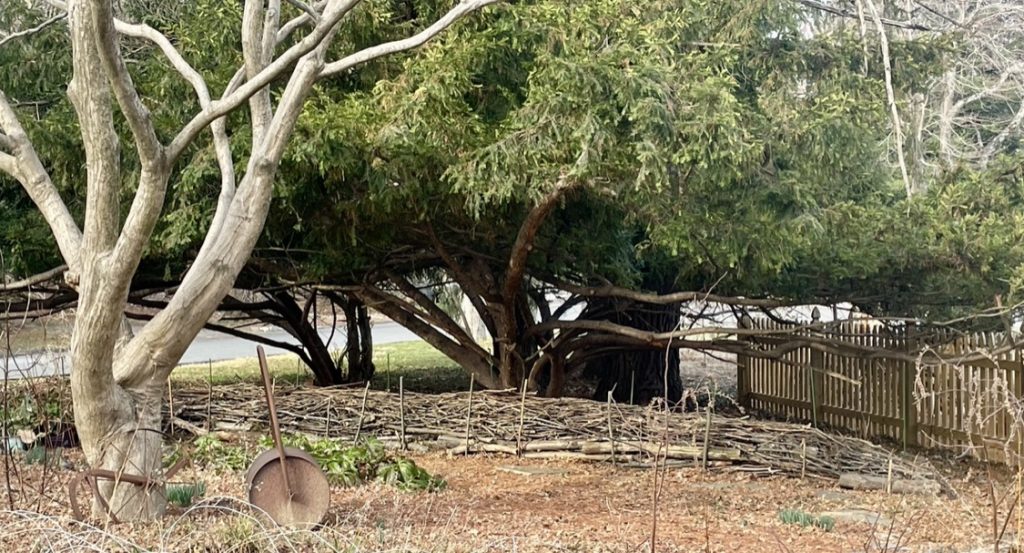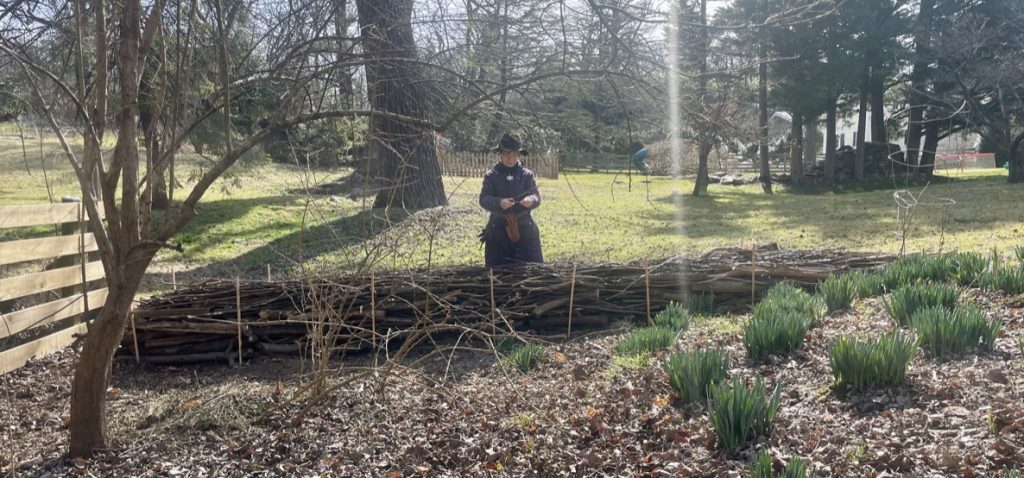My late friend, Fanny Phillips (1928–2004), was an enthusiast for many things. She wasn’t so much a gardener as a passionate collector and student of mostly exotic plants. She gave me my Bowiea volubilis (below right), as well as several flats of snowdrops from her compost piles, where they had naturalized. But she was especially devoted to the Amorphophallus species, including the gigantic Amorphophallus titanum, the famous corpse lily pollinated by carrion flies. (She and her husband Craig gave seedlings of this plant to the U.S. Botanic Garden and the Smithsonian and lived to see them come into triumphant bloom at last.)

Fanny grew species of Amorphophallus in her Silver Spring house and garden, and one thing she did routinely was to wander around her yard picking up twiggy sticks, breaking them up, and throwing them on her Amorphophallus garden beds. So I think of Fanny as I do the same thing, making slow mulch (artisanal, locally sourced). In this way she and I were following one of the principles of ecologically minded gardening: minimizing inputs and outputs. That is, trying to avoid things that require importing a lot of external inputs, such as fertilizer, pesticides, extra water, and effortful maintenance. (You shouldn’t try to have a lush green lawn in Arizona, for instance.) You also want to keep naturally occurring material in your garden, including capturing water and using organic material on site rather than having it hauled away. Just as nature uses all the leaves that fall to nourish the trees and soil as they gradually decompose, so as ecologically minded gardeners we try not to remove all our leaves and yard trimmings and give them to the county. (Of course, the county does turn those leaves and other material into nice LeafGro, but rather than buying it back, you might as well try to keep yours in the first place.)
So as well as producing slow mulch from twigs, I’ve been using logs and sticks to line paths in various ways, and of course making brush and stick piles. Many stick piles. I even developed piles of dead vines from my constant efforts to remove ivy, vinca, creeping euonymus, pachysandra, honeysuckle vine, porcelain berry, etc. (It takes a long time for pulled vines to really die and become brittle.)
So I was pleased to come across an idea that fits right in with the principle of minimizing outputs: “dead hedges” of cut wood and sticks. Famous gardener Nigel Dunnett makes these, both straight ones and curved “nests.” (So cool. Please search on the web!)
Basically, you can create hedge-like barriers from logs and sticks by stacking them not in a pile, but in a linear arrangement. First, drive two parallel lines of stakes into the ground along the area where you want your barrier. The stakes form the outline and support for your hedge. Then lay your logs, sticks, brush, and other debris down along the path between the stakes until you get a wall of wood and sticks.

In my case, I also flattened out and buried my old vines at the bottom of one hedge. I may add brush to the top as well, but at the moment I’m concentrating on sticks. We deviated from true purity by buying stakes rather than making our own, but we are producing some as we go along. Winter pruning provides the opportunity to turn the straighter, stronger branches into stakes.
Consolidating my scattered piles let me uncover areas for more planting. In those places where there had been stick piles, I find good soil (and lots of twig mulch), in which the remnants of smothered weeds and aggressive vines are easy to find and eradicate.

As structured stick piles, dead hedges provide useful habitat to small creatures, allow my wood and sticks to gradually decompose in situ, and provide me with physical and visual barriers, adding definition and structure. They also give me a satisfying sense of accomplishment as I wander the garden, admiring Fanny’s snowdrops and planning for spring.